In the third trimester, a pregnant woman may begin to experience training contractions. Without knowing about this phenomenon, you can get worried and decide that labor has begun. Of course, an extra visit to the doctor during pregnancy won’t hurt anyone, but excessive anxiety can only do harm to the expectant mother. In this article, we will tell you when training contractions begin during pregnancy, what they are, so that you can distinguish real contractions from false ones.
Training contractions during pregnancy: what is it, how to treat it?
False contractions in expectant mothers in late pregnancy were studied by John Braxton-Hicks, a physician in England in the 19th century. It is after him that in modern medicine the training contractions that prepare a woman for childbirth are named.
In fact, they are the same contractions of the uterus that occur during labor, but during them the cervix does not open. Not all pregnant women experience this phenomenon. According to modern doctors, false contractions are useful because they are a kind of preparation for childbirth. The expectant mother can practice with them how to breathe correctly, which is extremely important to learn in order to reduce the pain of contractions during childbirth. In addition, false contractions soften the cervix, the placenta is well supplied with oxygen. Therefore, training contractions are very useful not only for the woman, but also for the child.
At what stage of pregnancy do training contractions begin during the first pregnancy?
During the first pregnancy, training contractions can make themselves felt already from the second trimester - normally from the 20th week. This is an individual indicator for each expectant mother. In many cases, false contractions are not encountered at all during the first pregnancy, or they occur in the last weeks of pregnancy.
When do training contractions begin during a second pregnancy?
For multiparous women, it will be easy to distinguish when contractions are real and when they are training. Often, women who are pregnant for the second time do not have training contractions at all, because the body does not need them, since it is already prepared for labor. But due to the peculiarities of physiology, training contractions may still begin at 37 weeks or even earlier.
How to distinguish false contractions from labor ones?
When training contractions begin, expectant mothers are interested not only in how long they last, but also in how to distinguish them from real contractions. It is impossible to confuse them, since prenatal sensations are quite painful and intense. In general, labor pains are very individual in sensations. Some compare them to very severe menstrual pain, others to the sensation of diarrhea. Here are some signs of labor pains starting:
- discomfort and dull pain in the lower abdomen, which is felt every 10 minutes or more than 5 times per hour;
- the presence of regular contractions in the lumbar region;
- increased pressure in the pelvic area or vagina;
- colic that resembles menstrual colic;
- bleeding;
- nausea, vomiting and diarrhea;
- the presence of copious liquid discharge.
Why do training contractions occur during pregnancy?

Training contractions begin due to provoking factors, which include:
- Touching the belly of various kinds can excite the expectant mother, as a result of which the release of oxytocin, a hormone that promotes contractions of the uterus, will begin. The same process can cause a wild sex life of the expectant mother in the last weeks of pregnancy.
- Activity of the expectant mother and child in the womb. This is especially true in the second and third trimesters, when the belly is already noticeable.
- Bladder that is not emptied in a timely manner. If it is overfilled, it will begin to put pressure on the uterus, which may begin to contract due to pressure.
- If the expectant mother drinks little fluid during the day, she becomes dehydrated, which is the cause of training contractions.
- Severe stress, anxiety and other nervous shocks are factors that contribute to the occurrence of training contractions.
When to expect training contractions to appear
Braxton Hicks contractions can appear from the second trimester of pregnancy. It is impossible to predict the exact date. It is believed that during the first pregnancy they become noticeable later than during the second pregnancy.
The optimal time for false contractions to appear is after 36–38 weeks. By this time, the fetus has matured, its adrenal glands begin to function, and surfactant is produced in the lungs. Therefore, the gradual maturation of the cervix and the approach of labor are not dangerous and are physiological.
But some pregnant women experience Braxton Hicks contractions after 20–22 weeks.
The exact causes of this condition have not been established, but suggest the influence of the following factors:
- Dehydration is an insufficient supply of fluid and its active loss in hot weather, with preeclampsia, gestational diabetes.
- Stressful situations - severe emotional experiences, nervous tension at home and at work increases the release of norepinephrine, adrenaline, and increases the likelihood of uterine contractions.
- Overfatigue - women who do not reduce physical activity and spend a lot of time on their feet have a risk of false contractions.
- Full bladder – due to pressure on the lower segment of the uterus, reflex contractions may occur.
Training contractions can appear in primigravidas and when carrying a child again. A direct relationship with birth rate or parity has not been established.
How to recognize training contractions during pregnancy: symptoms, signs

The uterus is a muscular organ for which contractile activity is the norm. In general, the uterus periodically contracts throughout pregnancy, but these contractions are so weak that the expectant mother does not feel them.
Training contractions are noticeable, although not as painful as real contractions. How does the expectant mother feel when false uterine contractions occur:
- she feels tension in her stomach;
- she feels the uterus, she can even palpate it (the uterus will either stiffen or relax);
- all this lasts several seconds or minutes (the longest duration of training contractions is 2 minutes);
- there is no specific break between contractions - they are irregular;
- training contractions are practically painless - discomfort is felt, but there is no pain as such.
During training contractions, the expectant mother needs to listen to herself - lie on the sofa or in bed, place her hands on her stomach and completely relax. If the sensations are as we described above, then there is no reason to worry - you just need to rest a little and the cramping pain in the abdomen will pass.
If the pain intensifies and a certain periodicity appears between contractions, this also does not mean that you are in labor. This is just how you experience training contractions. But to know for sure, check with a specialist. Just keep in mind that in the later stages, during vaginal examinations, the expectant mother is no longer allowed to go home from the maternity hospital. She will have to stay there until the birth.
How do you feel the difference between training contractions and real ones?

To understand what practice contractions look like during pregnancy, you need to understand what real contractions are like. This is the only way you can figure out what is happening to you—real contractions:
- very painful, and the pain, although insignificant, is noticeable already in the early stages of labor;
- the pain, increasing, spreads not only to the entire abdomen, but also radiates to the lower back;
- contractions are regular - at first they are repeated every 15 minutes, so the frequency gradually decreases, and the duration of one contraction increases;
- at the last stage of labor, contractions become very intense - there can be 5 contractions in 1 minute.
If the contraction is real, then the amniotic fluid may flow out and the mucous plug may come away. Some women even experience diarrhea (the body starts the process of natural cleansing).
How do training contractions feel?
The sensations during this phenomenon in women vary in degree of intensity and strength. As a rule, during training contractions the following symptoms appear:
- pulling sensations similar to those that appear during menstruation;
- tension or compression in the uterus, groin, lower abdomen;
- painful sensations are concentrated in one area of the body and do not radiate to the back or lower back, as during real contractions;
- they are less painful than real ones, can be short-term and irregular;
- the muscles of the uterus can tense so much that a woman is able to feel this organ, sometimes clear contours of the uterus are visible;
- muscle contraction can cause pain, but is often limited to only discomfort for the pregnant woman.
What should you do if training contractions begin?

If training contractions begin to bother you, you will have to do a little research into your body to find out when these contractions are most noticeable and why they occur. If you manage to do this, then you can simply eliminate the factors that provoke them from your life and deliver your baby calmly and painlessly.
Experts recommend the following procedures that can alleviate the condition of the expectant mother during false labor:
- You can sit in a warm bath for 10 minutes. Only the water should not be hot.
- If contractions begin at night, then turn on your left side and lie in this state until the contractions are over.
- Lie down on a very soft surface (you can wrap yourself in a blanket or pillows) so that you are in a state of complete weightlessness.
- If contractions begin during the day, then it is better not to lie down, but to go out into the fresh air and take a walk.
- Drink a glass of water and do breathing exercises. We will tell you further about what exercises you need to do to alleviate your condition.
How to breathe correctly during training contractions?

Training contractions are a great opportunity to practice breathing techniques that will be needed during labor. There are 3 very good exercises that you can use:
- "Economy breathing" As soon as the contraction reaches its peak, you need to slowly exhale the air and then take a deep breath. As soon as the contraction ends, the exercise is repeated.
- "Like a dog." Have you seen how dogs breathe when they are very hot? Approximately the same thing should be done by a woman during labor. As soon as uterine spasm begins, you need to breathe frequently and shallowly for 20 seconds. You cannot spend more time on this, otherwise you may lose consciousness from lack of oxygen.
- "Blowing out the candles." This type of breathing will be useful to you in the first stage of labor, when contractions will increase in frequency and become more painful. What you need to do is take a slow, deep breath through your nose and exhale sharply through your mouth.
How to Reduce Discomfort from Braxton Hicks Contractions

Training contractions during pregnancy are usually well tolerated, but closer to the time of birth they can begin to cause significant discomfort. To make it easier, you can use simple techniques:
- Go to the toilet. A full bladder can stimulate uterine contractions. To relieve the condition, you can have a bowel movement.
- Relax . If Braxton Hicks contractions occur after a trip on public transport or psychological stress, you can lie down in silence, with the lights dimmed, or take a short nap.
- Change body position . When contractions occur at night, it is often enough to turn over to the other side. Some women prefer to get out of bed and walk around a bit.
- Take a walk . In good, cool weather, a pregnant woman can go for a walk. This will help ease contractions and oxygenate the blood. But you need to avoid roads along highways and near industrial enterprises; the optimal place is a coniferous park.
- Eliminate fluid deficiency . You can drink a glass of water at room temperature, which will be absorbed faster than cold liquid. Warm tea, compote or fruit juice helps a lot. It is allowed to use soothing tea.
- Perform breathing exercises. It will help distract you from unpleasant sensations and saturate your blood with oxygen.
- Take a warm shower. Water will help relieve tension, relax muscles and reduce contractions.
In what cases should you immediately consult a doctor?

False contractions are not always harmless. They need to be treated carefully, because in some cases there is a need to immediately consult a doctor, especially if they began not at the 40th week of pregnancy, but much earlier. If no measures are taken, the woman may give birth prematurely or lose the child.
In what cases should you immediately call an ambulance and go to the hospital for examination by a doctor:
- If you notice that after a contraction there is blood on your underwear (even if in a small amount), there is a possibility that the placenta has separated. In this case, a trip to the hospital is mandatory.
- If the underwear becomes wet, it means that amniotic fluid has begun to leak, since as a result of the contraction the bladder has ruptured.
- If after going to the toilet you see a lump of mucus with bloody streaks, this means that your mucus plug has begun to come off. You should see a doctor because your child has thus lost protection against infections.
- If during a contraction you feel unbearable pain in the abdomen and lower back, go to the hospital.
- If after training contractions the child begins to move less, immediately go to the maternity hospital, because this may mean that the child’s life is in danger.
- If after a contraction you feel strong pressure in the perineal area, it is possible that you are already in labor and your baby will soon be born.
- If the frequency of contractions has become constant, go to the maternity hospital, because these are no longer training contractions, but real ones.
When you arrive at the maternity hospital, tell the doctor everything that happened to you, how you felt. Your doctor will decide whether to do a vaginal exam and prescribe procedures that will help you feel better about your condition. Pregnant women, worried about giving birth, immediately panic. In fact, there is no need to panic, on the contrary, you need to pull yourself together, calm down and think about the child, because during labor he is worse than the mother.
Training contractions are, in any case, not the most pleasant occurrence in the life of a pregnant woman. However, you should not perceive them as a sentence or punishment. Remember that many women who have experienced false contractions find it easier to give birth; the whole process happens faster for them, because the cervix is fully prepared for childbirth.
Can false contractions be regular?
My pregnancy was going great. No toxicosis, pain, problems with tests... The only thing is chronic fatigue in the first trimester, but this is an almost permanent condition for me)) Before giving birth, I didn’t feel pregnant at all, I could walk for hours, I slept well, the energy was just gushing out of me. all possible places.
I wasn’t afraid of childbirth; it seemed to me that they, too, were simply bound to be easy and wonderful. I’m an athlete, I’m not afraid of pain (well, childbirth can’t be worse than stretching, haha), I did yoga until the 39th week. In addition, my husband and I took courses to prepare for childbirth, during which we were very persistently told that everything would be just fine. Therefore, my mood was very rosy.
And naturally everything went wrong. Moreover, from the very beginning. From the moment it became clear that I would not give birth before the PDA. The baby refused to leave her home. I categorically did not want to go to the maternity hospital in advance. Well, not at all. I've heard a lot of scary stories about stimulation and cesarean sections with the goal of quickly dying from a woman in labor (there are fewer forums to read, by God). Therefore, when at 40 weeks and 3 days I was placed in prenatal care, it was simply a disaster. And when the next morning my doctor came and said that she needed to leave for personal reasons, that she would not be at the birth and she was handing me over to another person, I literally became hysterical.
It was November 24, around 9-10 am. And at 12 o’clock they took me for an examination and offered to do a test to see if my cervix was ready for childbirth. As it turns out, they simply put a quarter of an oxytocin tablet in there, which naturally provokes contractions. Another hour later I was asked to go to the delivery room. I understood that this meant stimulation, because... There were no traces of normal contractions or meaningful dilatation. But, frankly speaking, I didn’t care anymore. I gave up and let everything take its course. Especially considering that the day before I had false contractions for almost a day with varying success and at night I only managed to sleep for a few hours. I was tired, on nerves and wanted everything to end as quickly as possible.
So, I ended up in the delivery room at about 2 o’clock in the afternoon. And exactly in the one I wanted - there was a jacuzzi there (YES!). Voluntarily went for an enema. Because I was already worried that my husband would have to see me not in the most attractive form and did not want to burden his psyche with possible additional troubles)) Not the most pleasant procedure, I must say, but nothing fatal. When I returned, my husband was already waiting for me. He didn’t know until recently that he was going to the birth, he thought he was just going to visit. Well done, so to speak))
Then complete trash began. Almost immediately my bladder was punctured. Moreover, he did not want to inject himself; they defeated him with difficulty during the fight. The waters turned green and muddy. Very green in color and very cloudy... As I later found out, the baby poops meconium in the womb during hypoxia. Which in my case was not surprising, because... The placenta turned out to be in very poor condition as a result. Why they didn’t see this on the Doppler is a mystery to me... Well, okay, that’s not about that now.
Meconium fluids completely killed the likelihood of a normal birth (well, more precisely, the way I imagined it would be). But there was a very real opportunity to go for an emergency caesarean section. I was very lucky that my doctor supported my desire to give birth on my own. Truth warned me that I needed to speed up the process as much as possible (which meant constant stimulation with oxytocin), that it was impossible to give pain relief due to the likelihood of a cesarean (which meant hellish pain from stimulated contractions), that due to the same likelihood I could not eat anything and , if possible, not to drink (which is simply terrible, because I want to drink constantly) and that I must be constantly connected to CTG, because if the baby’s heartbeat drops below 100, we urgently run for a caesarean section (which meant the impossibility of choosing different positions for contractions, i.e. .k. CTG significantly limits the ability to move). A bright prospect, to say the least...
In general, we didn’t succeed quickly. My body said that it was not going to give birth today, and went into deep unconsciousness. Labor was carried out exclusively on oxytocin. Over the entire period, 3 or 4 times they put a pill in my neck, 5 pills were eaten and one dropper was inserted. The climax of my torment was the visit of the senior shift doctor, who tried to dilate the cervix manually (well, more precisely, pull it out so that the dilatation would go faster). At the same time, I chewed an oxytocin tablet, and the midwife carefully twisted my nipples. It was hell. It seems to me that they even torture more humanely, honestly. It was at that moment that for the first time I seriously thought about the fact that a caesarean section was not such a bad idea... If immediately after that, having heard enough of my screams and seen enough of my torment, I had not been allowed to unfasten myself from the ill-fated CTG (over the past 3 After an hour, the child’s heartbeat never fell below 130, so we decided to take a short break in observation) and give birth in the way that is convenient for me, then, by God, I would spit on all my beliefs and would ask for a Caesarean myself.
And then, finally, I was able to get to the coveted bathroom. Lyrical digression. Girls, if you have the opportunity to be in the water during contractions, don’t miss it! This is an indescribable thrill. The main thing is that the water is hotter. I am sure that if I had the opportunity to spend all the time in the bathroom, the birth would have been much easier. This was the only period when I had normal, regular contractions without stimulation. Apparently because I was able to relax and focus on the process.
But, unfortunately, the scam ended quickly. I sat there for an hour at most, then I had to get out to monitor the child’s condition again. And the fun began again.
In total, I spent 10 hours in the delivery room. When it became clear that the child’s condition was stable, I was given additional mobility. I could walk, squat, hang on my husband... Only periodically they connected me to the device for 10-15 minutes, made sure that everything was fine, and let me go on a walk. They weren’t allowed into the bathroom anymore, because pulling me out of there every half hour was not an option.
Around 8 pm I started pushing. Which was not very good, because there was never a complete opening (about 8 centimeters, if I remember correctly). In addition, the baby still could not stand up correctly and lower her head into the pelvis, I understood that she was lying in an uncomfortable position, it was necessary for her to turn around. I was forced to walk to help her get into position. How many circles were wound from the window sill to the table... The distance there is about 5 meters, but I could walk exactly that between contractions. At some point, it was decided to put me on an oxytocin drip. I lost track of time...
The decisive moment came at 23-30. I very clearly remember how I stood near the table, with an IV in my hand and a pill in my mouth (everywhere this oxytocin was shoved into me, honestly), and I realized that my contractions were fading away, full dilation had not yet occurred, and If I don’t give birth before 12, I’ll most likely go for a caesarean section. And the doctor also understood this, apparently, because it was at that moment that she waved her hand and told me to forget about walking and do whatever was convenient for me and how it was convenient for me. And, lo and behold!, at 11:45 pm my little girl was born!))
As I say, I gave birth to her in a psychotic state. Well, I didn’t want to go for a caesarean section after 10 hours of suffering! In some incomprehensible way, I was able to move the baby from a dead point, the head began to move, in a second a bunch of doctors surrounded me, laid me on the table, manually dilated the cervix, and literally in 2 minutes the baby came out completely. I have always believed that the most painful process is the birth itself, when the child walks through the birth canal. So, I didn’t even feel it. Just at the next push, I opened my eyes and saw that the head had already been born. And after about 20 seconds the whole body came out))
The second shock was that at the very moment when she was plopped on my stomach, all memories of pain were cut off from me. At all. I'll feed it. I was ready to run for my second child right now!
And then everything again did not go as we planned. The umbilical cord was cut instantly (we wanted and agreed to wait for the end of the pulsation) and the neonatologists dragged the baby away. My doctor explained that the baby should not be allowed to cry until her airway was cleared of meconium. Therefore, it was impossible to wait with the umbilical cord. Oh, how long the moments stretched before her first cry... Then they fiddled with her for a very long time, sucked out the mucus that did not want to be sucked out, washed her, dressed her... During this time they managed to patch me up a little. I had a rupture in my neck (which is not surprising, since I was pushing it without full dilatation) and another internal one. And then I grabbed another bonus - they decided to sew me without pain relief, because... no one knew if I was allergic to the anesthetic (including me, because I had never taken pain relief from anything). But after the first seam they took pity and decided to take a risk. At least I'm lucky here))
We spent the next three hours in the delivery room. The neonatologist didn’t want to let us into the ward because the baby was wheezing a lot. The mucus in the lungs was very thick and viscous, and did not want to come out completely. She was also worried that the child might have swallowed dirty water, which could lead to intestinal infections. As a result, she talked us into sending the child to the children's department for the rest of the night for observation. At 4 in the morning, my husband and I found ourselves in the ward, tired but happy, and at about 6:30 our miracle was returned to the family. And from that moment on, we finally and irrevocably became three)))
Despite not the most favorable circumstances during the birth, the child turned out to be simply wonderful, weighing 3320 and 54 cm tall, and most importantly, healthy and most beloved. By the way, they predicted that I would have a large baby, at the consultation they put it at least 3600, but according to the ultrasound before the birth they counted it at 3900. Oh well…
In general, perhaps the moral of this story is that it is categorically undesirable to set yourself up for any specific birth scenario. Reality can be cruel. And nerves because something went wrong can significantly complicate the process. It seems that this is exactly what happened to me)) As a result, I made several conclusions for the future (perhaps someone will be interested).
Firstly, be prepared for the fact that various unforeseen circumstances may arise and be mentally prepared for this.
Secondly, listen not only to doctors, but also to yourself. In my particular case, I perfectly understood that walking did not help, but I was silent about it (the doctor knows better). If I had started doing what was convenient for me earlier, then perhaps we would have managed it faster.
Thirdly, do not be so categorical about Caesarean. Again, in my case, it could have been a lesser evil if it had been done on time. The fact is that the birth resulted in a complication, for which I had to undergo surgery anyway.
In general, childbirth is just a day in your life (maximum), after which you will have a small miracle in your arms for the rest of your life. And it is definitely worth enduring all this!
All the best, mommies - healthy babies, pregnant women - easy weeks and childbirth!











